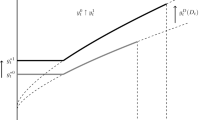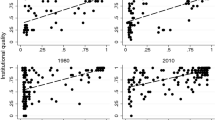Abstract
This is the first study that assesses the economic effects of direct democratic institutions on a cross-country basis. We find that total spending as well as spending on welfare is lower in countries with mandatory referendums, consistent with the previous literature. But we also find that countries with national initiatives appear to spend more and be more corrupt. Finally, budget deficits, government effectiveness, productivity and “happiness” appear unrelated to direct democracy. Institutional detail thus matters a great deal. In general, the effects of direct-democratic institutions become stronger if the frequency of their actual use is taken into account. Effects are usually stronger in countries with weak democracies.
Similar content being viewed by others
References
Aaken, A. V., Feld, L., & Voigt, S. (2008). Power over prosecutors corrupts politicians: cross country evidence using a new indicator. Available at: http://papers.ssrn.com/sol3/papers.cfm?abstract_id=1097675.
Alt, J., & Lassen, D. (2003). The political economy of institutions and corruption in American states. Journal of Theoretical Politics, 5(3), 341–365.
Banks (2004). Cross-national time-series data archive, 1815–2003 [electronic resource]. Binghamton, NY: Databanks International.
Barro, R. J. (2000). Rule of law, democracy, and economic performance. In Heritage foundation: the index of economic freedom (pp. 31–49) Washington D.C.
Beck, T., Clarke, G., Groff, A., Keefer, P., & Walsh, P. (2000). New tools and new tests in comparative political economy: the database of political institutions. Washington: The World Bank.
Ben-Bassat, A., & Dahan, M. (2008). Social rights in the constitution and in practice. Journal of Comparative Economics, 36, 103–119.
Benz, M., & Stutzer, A. (2004). Are voters better informed when they have a larger say in politics?—Evidence for the European Union and Switzerland. Public Choice, 119, 31–59.
Blomberg, S., Hess, G., & Weerapana, A. (2004). The impact of voter initiatives on economic activity. European Journal of Political Economy, 20(1), 207–226.
Blume, L., Müller, J., Voigt, S., & Wolf, C. (2007). The economic effects of constitutions: replicating—and extending—Persson and Tabellini. CESifo Working Paper Series No. 2017.
Buchanan, J., & Tullock, G. (1962). The calculus of consent—logical foundations of constitutional democracy. Ann Arbor: University of Michigan Press.
Dalton, R. (forthcoming). Direct democracy and good governance: does it matter? In: S. Bowler & A. Glazer, (Eds.). The impact of direct democracy. Palgrave.
Feld, L., & Kirchgässner, G. (2001). The political economy of direct legislation: direct democracy and local decision-making. Economic Policy, 33, 329–363.
Feld, L., & Matsusaka, J. (2003). Budget referendums and government spending: evidence from Swiss cantons. Journal of Public Economics, 87, 2703–2724.
Feld, L., & Savioz, M. (1997). Direct democracy matters for economic performance: an empirical investigation. Kyklos, 50(4), 507–538.
Feld, L., Schaltegger, C., & Schnellenbach, J. (2008). On government centralization and fiscal referendums. European Economic Review, 52, 611–645.
Feld, L., & Voigt, S. (2003). Economic growth and judicial independence: cross-country evidence using a new set of indicators. European Journal of Political Economy, 19(3), 497–527.
Fiorino, N., & Ricciuti, R. (2007): Determinants of direct democracy. CESifo Working Papers No. 2035.
Freedom House (2000). Press Freedom Survey 2000. Downloadable from: http://freedomhouse.org/pfs2000/method.html.
Frey, B. (1994). Direct democracy: politico-economic lessons from Swiss experience. American Economic Review, 84(2), 338–342.
Frey, B. (1997). A constitution for knaves crowds out civic virtues. The Economic Journal, 107, 1043–1053.
Frey, B., & Stutzer, A. (2000). Happiness, economy and institutions. The Economic Journal, 110, 918–938.
Frey, B., & Stutzer, A. (2006). Direct democracy: designing a living constitution. In R. Congleton (Ed.), Democratic constitutional design and public policy—analysis and evidence. Cambridge: MIT Press.
Funk, P., & Gathmann, C. (2005). Estimating the effect of direct democracy on policy outcomes: preferences matter! Available at: http://papers.ssrn.com/sol3/papers.cfm?abstract_id=784446.
Hall, R., & Jones, C. (1999). Why do some countries produce so much more output per worker than others? The Quarterly Journal of Economics, 114(1), 83–116.
Hwang, J.-Y. (2005). Direct democracy in Asia: a reference guide to the legislation and practice. Taiwan Foundation for Democracy Publication.
Initiative and Referendum Institute Europe (2005). Guidebook to direct democracy. Amsterdam.
Kaufmann, B. (2004). Initiative and Referendum Institute Europe (2005). Initiative & Referendum Monitor 2004/2005.
Kaufmann, D., Kraay, A., & Mastruzzi, M. (2003). Governance matters III: governance indicators for 1996–2002. World Bank Policy Research Department Working Paper.
Kaufmann, B., & Waters, D. (2004). Direct democracy in Europe: a comprehensive reference guide to the initiative and referendum process in Europe. Carolina: Academic Press.
Kirchgässner, G., & Frey, B. (1990). Volksabstimmung und direkte Demokratie: Ein Beitrag zur Verfassungsdiskussion. In H. D. Klingmann & M. Kaase (Eds.), Wahlen und Wähler—Analysen aus Anlaß der Bundestagswahl (pp. 42–69). Opladen: Westdeutscher Verlag.
Lascher, E., & Wassmer, R. (2007). Reconsidering claims about the secondary benefits of direct democracy. Mimeo, Dept. of Public Policy and Administration, California State University at Sacramento.
Lipset, S. M. (1959). Some social requisites of democracy: economic development and political legitimacy. American Political Science Review, 53(1), 69–105.
Madronal, J. C. (2005). Direct democracy in Latin America. Mas Democracia and Democracy International.
Martin, M.-J. (2005). A theoretical basis for the consideration of spending thresholds in the analysis of fiscal referendums. Constitutional Political Economy, 15, 359–370.
Matsusaka, J. (1995). Fiscal effects of the voter initiative: evidence from the last 30 years. Journal of Political Economy, 102(2), 587–623.
Matsusaka, J. (2000). Fiscal effects of the voter initiative in the first half of the twentieth century. Journal of Law & Economics, 43, 619–650.
Matsusaka, J. (2004). For the many or the few. the initiative, public policy, and American democracy. Chicago: The University of Chicago Press.
Matsusaka, J. (2005). Direct democracy works. Journal of Economic Perspectives, 19(2), 185–206.
Matsusaka, J. (2007). Disentangling the direct and indirect effects of the initiative process. Mimeo, University of Southern California, June 2007.
Matsusaka, J., & McCarty, N. (2001). Political resource allocation: benefits and costs of voter initiatives. The Journal of Law, Economics & Organization, 17(2), 413–448.
Mueller, D. (2003). Public choice III. Cambridge: Cambridge University Press.
Persson, T., & Tabellini, G. (2003). The economic effects of constitutions: what do the data say? Cambridge: MIT Press.
Pommerehne, W. (1983). Private vs. öffentliche Müllabfuhr: Nochmals betrachtet. Finanzarchiv, 41, 466–475.
Pommerehne, W. (1990). The empirical relevance of comparative institutional analysis. European Economic Review, 34, 458–468.
Pommerehne, W., & Weck-Hannemann, H. (1996). Tax rates, tax administration and income tax evasion in Switzerland. Public Choice, 88, 161–170.
Roubini, N., & Sachs, J. (1989). Political and economic determinants of budget deficits in the industrial democracies. European Economic Review, 33, 903–938.
Smith, D., & Tolbert, C. (2004). Educated by initiative. Ann Arbor: University of Michigan Press.
Tavares, J., & Wacziarg, R. (2001). How democracy affects growth. European Economic Review, 45, 1341–1378.
Torgler, B. (2005). Tax morale and direct democracy. European Journal of Political Economy, 21, 525–531.
Veenhoven, R. (2004). World database of happiness, catalog of happiness in nations. Downloadable from: http://www.eur.nl/fsw/research/happiness, last assessed on Sep 20, 2004.
World Values Study Group (2004). World values survey 1981–1984, 1990–1993, 1995–1997, and 1999–2001. Inter-university Consortium for Political and Social Research, Ann Arbor.
Author information
Authors and Affiliations
Corresponding author
Rights and permissions
About this article
Cite this article
Blume, L., Müller, J. & Voigt, S. The economic effects of direct democracy—a first global assessment. Public Choice 140, 431–461 (2009). https://doi.org/10.1007/s11127-009-9429-8
Received:
Accepted:
Published:
Issue Date:
DOI: https://doi.org/10.1007/s11127-009-9429-8




